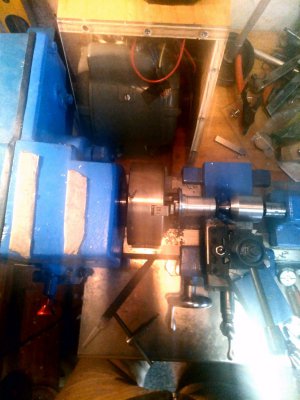I adapt a high tech motorcycle fork damper to fit my Norton Commando forks. I have to make a few different parts. I use the appropriate cutting speeds for those parts. The trickiest part I modify is the aluminum fork damper cap with it's integrated controls. The stock modern fork cap is wider than the Norton fork, but there's plenty of meat to turn it down and re-thread it to the Norton fork tube size threads (about 1-1/8" diameter x 20 tpi) I reduce the diameter of the fork cap at the proper calculated speed (about 1,700 rpm) but I slowed the rpm's down greatly to do the threading. The result was horrible and not a usable part at all. I can replace the fork cap nut pretty cheaply on ebay and give it another go, which is the plan, so,...
I have a question about threading aluminum and the choice of turning speed. As the speed of cutting moves toward the optimum speed for the best result, is there a mathematical progression in the increase of the quality of the cut? If I try, 450 rpm /900 rpm /1350rpm /1700rpm will I get a steadily increasing quality or is there a threshold based on the alloy or some other quality of aluminum that dictates the quality of threading. Is there something particularly about single point threading that requires consideration?
For example: I might be totally comfortable cutting down the diameter at 1,700 rpm's but not so comfortable threading at that speed. What are the solutions.
1) Suck it up and get comfortable at the 1,700 rpm speed cutting going away from the headstock with an upside down cutter where there's inches of safe space to stop the carriage.
2) Find a speed where things happen slow enough for you to feel comfortable and accept a slightly lower result
3) Something else?
*Feel free to mention anything that you feel I might be unaware of. Thank you in advance for any help


